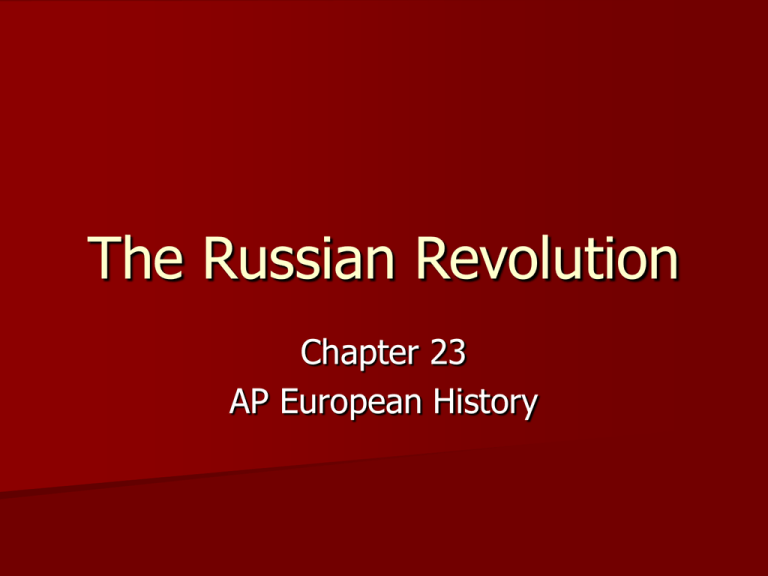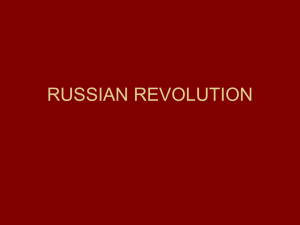The Russian Revolution Chapter 23 AP European History
advertisement

The Russian Revolution Chapter 23 AP European History Recap… Unrest in 1800’s and early 1900’s – Decembrist Revolt (1825) – Loss of war= demand for reform Crimean War Russo-Japanese War Recap… Reforms of Alexander II – Prompted by loss in Crimean War – Created local government positions – Emancipation of serfs Recap… Social and economic inequality helps popularize various ideas (Marxism, etc.) Intelligentsia help to spread these ideas – Government will attempt to “shut them up” Assassination of Alexander II leads to a backlash – Russification Revolution of 1905 Russia’s loss in the Russo-Japanese War again leads to revolt Thousands of people marched on the tsar’s Winter Palace demanding reform – Troops fired on the crowd – “Bloody Sunday” News of the massacre spread, leading to anti-government demonstrations Bloody Sunday Revolution of 1905 Nicholas II (ruled from 1894-1917) agreed to a few reforms – New constitution – Creation of a parliament (Duma) – Forgive redemption payments that former serfs were required to pay in return for communal lands (mir) – Relaxation of Russification policies The Last of the Russian Tsars Alexei’s illness The Emperor wrote to his mother: “The days from the 10th to the 23rd were the worst. The poor child suffered greatly; the pain was sporadic, occurring every 15 minutes. He hardly slept at all, did not have the strength to cry but only moaned, repeating the same words all over again: “Lord have mercy on me.” I could not stand it but had to remain in the room in order to relieve Alix who had exhausted herself completely, spending every night at his bedside. She bore this trial better than I, especially when Alexis’ sufferings were at their worst.” An eye witness of Alexei’s illness write: “The crown-prince lay in bed, and moaned pitiably, pressing his head to his mother’s hand, his fine face bloodless, unrecognizable. From time to time he stopped moaning to whisper only one word: “Mama,” in which he expressed all his suffering, all his heart-break. And the mother would kiss his hair, his forehead, his eyes, as if by this caress she could lighten his pain, breathe into him some of that life which was leaving him.” Russia During WWI Fought with Allies Highest casualty rates Poorly equipped Dissatisfaction among troops Food shortages and civil unrest The February Revolution February, 1917: Revolution broke out in Petrograd (formerly St. Petersburg) Workers went on strike in memory of “Bloody Sunday” – Tens of thousands demonstrated in the streets Discontent and mutiny in the military March 2, 1917: Nicholas II abdicates throne – March 15 in the western calendar Abdication of Tsar Nicholas II In the days of the great struggle against the foreign enemies, who for nearly three years have tried to enslave our fatherland, the Lord God has been pleased to send down on Russia a new heavy trial. Internal popular disturbances threaten to have a disastrous effect on the future conduct of this persistent war. The destiny of Russia, the honor of our heroic army, the welfare of the people and the whole future of our dear fatherland demand that the war should be brought to a victorious conclusion whatever the cost. The cruel enemy is making his last efforts, and already the hour approaches when our glorious army together with our gallant allies will crush him. In these decisive days in the life of Russia, We thought it Our duty of conscience to facilitate for Our people the closest union possible and a consolidation of all national forces for the speedy attainment of victory. In agreement with the Imperial Duma We have thought it well to renounce the Throne of the Russian Empire and to lay down the supreme power. As We do not wish to part from Our beloved son, We transmit the succession to Our brother, the Grand Duke Michael Alexandrovich, and give Him Our blessing to mount the Throne of the Russian Empire. We direct Our brother to conduct the affairs of state in full and inviolable union with the representatives of the people in the legislative bodies on those principles which will be established by them, and on which He will take an inviolable oath. In the name of Our dearly beloved homeland, We call on Our faithful sons of the fatherland to fulfill their sacred duty to the fatherland, to obey the Tsar in the heavy moment of national trials, and to help Him, together with the representatives of the people, to guide the Russian Empire on the road to victory, welfare, and glory. May the Lord God help Russia! Provisional Government A provisional government was created, largely under the leadership of Alexander Kerensky (Prime Minister) Soviets (workers’ councils) were created to lobby for the rights of workers and the people Despite the efforts of the provisional government, the revolution continued to spread Lenin Vladimir Lenin: leader of the Bolsheviks – had been exiled to Switzerland in 1900 Lenin returned to Russia in April, 1917 Began to buildup his following Lenin “April Theses” – Series of publications by Lenin in which he advocates revolution – Outlines the views of the Bolsheviks Major ideas: – – – – Demand that Russia withdraw from WWI Opposed to the provisional government Attempt to spread the revolution to other countries Redistribution of land to the peasants – Calls for Soviet control of the state The July Days Despite the revolution, the provisional government kept Russia in WWI – Ordered a new offensive in June, 1917 July, 1917: Bolsheviks lead another insurrection Known as the “July Days” October Revolution October, 1917: the provisional government collapsed Also known as the Bolshevik Revolution Russia withdraws from WWI December, 1917: Russia signed an armistice with Germany March, 1918: Russia and Germany signed the Treaty of Brest-Litovsk The Bolshevik Revolution In 1918, a civil war broke out between the Bolsheviks and their opposition – “Reds”- Bolsheviks – “Whites”- anti-Bolsheviks The government nationalized all land – Land redistribution The Bolshevik Revolution July 17, 1918: Royal family brutally murdered Bolsheviks became known as the Communist Party September, 1918: “Red Terror” began – Forced labor camps to eliminate opposition – Fighting continued between the Red Army and the White army. The Bolshevik Revolution June, 1919: Large-scale industries are nationalized New Economic Policy: (NEP) – Lenin’s economic plan for Russia – Government maintained control over industry – Peasants were still permitted to use land for market agriculture – Created a “mixed” economy The USSR is born 1922: The Union of Soviet Socialist Republics (USSR, also known as the Soviet Union) was formed The Power Struggle 1922: Lenin suffered a stroke. – A power struggle began between Joseph Stalin and Leon Trotsky 1924: Lenin died and Stalin takes over Under Stalin’s rule, the Soviet Union became even more totalitarian.







